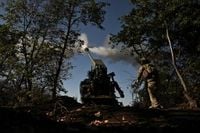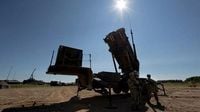In a significant move that underscores the deepening ties between Ukraine and its Western allies, President Volodymyr Zelenskyy announced on September 17, 2025, that the first shipments of military aid under a new, NATO-led program will include highly prized missiles for the Patriot air defense systems and HIMARS rocket launchers. The announcement, made during a joint press conference in Kyiv with European Parliament President Roberta Metsola, highlights the growing urgency and scale of Western support as Ukraine braces for another winter of conflict and intensifying Russian attacks.
According to Reuters, the aid is being coordinated through the Prioritized Ukraine Requirements List (PURL), a mechanism that pools contributions from NATO members—excluding the United States—to purchase U.S.-made weapons, munitions, and equipment for Ukraine. As of mid-September, Ukraine had secured over $2 billion in financing through the PURL initiative, with President Zelenskyy expressing confidence that the total committed funds would reach $3.5 billion by October. “We received more than $2 billion from our partners specifically for the PURL program,” Zelenskyy stated, as reported by European Pravda. “We will receive additional money in October. I think we will have somewhere around $3.5-3.6 billion.”
The initial two batches of weapons, each valued at $500 million, are set to "definitely include air defense missiles," Zelenskyy confirmed. While he declined to provide exhaustive details on the full contents of the shipments, he was unequivocal about the inclusion of missiles for the Patriot and HIMARS systems—both of which have become critical assets for Ukraine’s defense against relentless Russian missile and drone attacks. "These packages, I will not go into all the details, will definitely include missiles for Patriot and Himars," Zelenskyy said, according to European Pravda.
The PURL mechanism represents a novel approach to military aid, with NATO allies collectively funding the acquisition of American weaponry for Ukraine. The U.S. administration has approved the first military aid packages under this system, and European countries have pledged around $2 billion to the mechanism so far, with hopes of eventually providing up to $10 billion worth of weapons through this approach, Ukrainska Pravda reported. On September 17, Ukraine’s Ministry of Foreign Affairs confirmed that Washington had approved the first batch of American weapons for Ukraine under this arrangement.
Patrick Turner, NATO’s senior representative in Ukraine, told Reuters that the process is already well underway: “Four packages under the Prioritized Ukraine Requirements List have already been funded and equipment is already flowing.” This rapid mobilization comes as Ukraine faces mounting pressure on multiple fronts. The country remains heavily dependent on Western-supplied long-range air defense systems to intercept Russian missiles, which have caused significant civilian casualties and widespread infrastructure damage since the full-scale invasion began more than three years ago.
As the heating season approaches, Ukrainian officials are bracing for a possible escalation in Russian strikes targeting the country’s already battered energy system, including gas infrastructure. The risk of increased attacks on critical infrastructure has heightened calls from Kyiv for additional air defense supplies. “The Patriot systems are vital to defend against Russian missile attacks,” Associated Press noted, emphasizing the importance of these deliveries for Ukraine’s survival and resilience.
Recent events have underscored the volatility of the conflict. On the night of September 16-17, Russian forces launched a massive aerial assault on Ukraine, deploying 172 drones and missiles, according to Ukraine’s air force. Ukrainian air defenses managed to shoot down or jam 136 drones across the north, south, and east of the country. Nevertheless, the strikes caused disruption to rail and power services, and a Russian glide bomb struck a town in the southern Kherson region, wounding three women and a 3-year-old girl, regional head Oleksandr Prokudin reported.
The broader security situation in Eastern Europe remains tense. Russia closed Volgograd airport and placed oil refineries on alert on September 18 amid fears of a Ukrainian drone attack. Meanwhile, a missile incident in Poland on the night of September 9-10, involving drones violating NATO airspace, prompted a swift investigation by Polish authorities. Polish Prime Minister Donald Tusk insisted that all responsibility for the damage lay with Russia, which he accused of orchestrating a provocation using drones.
In response to the growing threat from Russia, Denmark announced on September 17 that it would, for the first time, acquire long-range precision weapons to bolster its defense capabilities. Danish Prime Minister Mette Frederiksen described the move as “a paradigm shift in Danish defence policy,” adding that Russia would remain a threat to Denmark and Europe “for years to come.” The announcement drew a sharp rebuke from Russia’s ambassador to Denmark, who called it “pure madness” and likened it to “threatening a nuclear power publicly.” Frederiksen, in turn, dismissed the ambassador’s remarks as an attempt to intimidate Europe and NATO.
Amid these security challenges, Ukraine and the U.S. International Development Finance Corporation announced a $150 million joint investment fund on September 17 to support Ukraine’s reconstruction and long-term economic recovery. Each side will contribute $75 million to the fund, which is part of a broader minerals deal signed in April. The fund is intended to spur investments in critical sectors such as energy, infrastructure, and mining, with a goal of financing three projects by the end of 2026. Ukrainian Economy Minister Oleksii Sobolev described the fund as a “beacon” that could attract further support from international institutions. “This is enough to launch the first significant investments,” he said, as reported by Associated Press.
Meanwhile, Lithuania charged 15 people with terrorism offences over an alleged Russia-backed plot to detonate explosive parcels in Germany, Poland, and Britain last year. Prosecutors allege that the suspects, who include Russian, Lithuanian, Latvian, Estonian, and Ukrainian citizens, used delivery companies to send parcels rigged with explosives, causing three explosions and sparking an international investigation.
As Ukraine prepares for another difficult winter, the arrival of new Western-funded weaponry—particularly advanced air defense missiles—could prove pivotal in protecting civilians and critical infrastructure from Russian attacks. The unprecedented level of international coordination and investment signals a renewed commitment to Ukraine’s defense and reconstruction, even as the prospect of peace remains elusive. With billions in military aid on the way and new security partnerships taking shape, Ukraine’s fight for sovereignty enters a new phase—one marked by hope, resilience, and the unwavering support of its allies.





